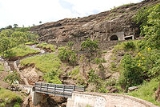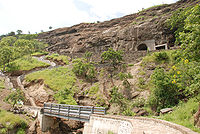
Aurangabad Caves
Encyclopedia
The Aurangabad caves are 12 artificial rock-cut Buddhist
shrines located on a hill running roughly east to west, nearly 2 km north from Bibi Ka Maqbara
in Aurangabad, Maharashtra
. The first reference of Aurangabad Caves is cited in the big Chaitya of Kanheri. The Aurangabad Caves were dug out of comparatively soft basalt
rock during the 6th and 7th century. Caves are divided into three separate groups depending on their location. Sculptural carvings of Aurangabad Caves reached belong to highest achievements of Indian classical art and can be compared to the best paintings of Ajanta.
 Carved in the Sihaychal ranges, overlooking the sprawling campus of Dr Babasaheb Ambedkar Marathwada University, the Aurangabd caves somewhat have been overshadowed by the UNESCO World Heritage monuments of Ellora
Carved in the Sihaychal ranges, overlooking the sprawling campus of Dr Babasaheb Ambedkar Marathwada University, the Aurangabd caves somewhat have been overshadowed by the UNESCO World Heritage monuments of Ellora
and Ajanta cave temples. Though its sculptures are comparable with the best in Ajanta and Ellora, scholars continued to disregard this cave group.
Though in the 20th century, a few scholars started looking at these cave temples as a missing link between Ajanta and Ellora and also after an exhaustive study, were compelled to describe it as a “ Sensitive remaking of life situated in time and space span”.
Buddhism
Buddhism is a religion and philosophy encompassing a variety of traditions, beliefs and practices, largely based on teachings attributed to Siddhartha Gautama, commonly known as the Buddha . The Buddha lived and taught in the northeastern Indian subcontinent some time between the 6th and 4th...
shrines located on a hill running roughly east to west, nearly 2 km north from Bibi Ka Maqbara
Bibi Ka Maqbara
Bibi Ka Maqbara is a maqbara built by the Mughal Prince Azam Shah, in the late 17th century as a loving tribute to his mother, Rabia Durrani . The comparison to the Taj Mahal has resulted in a general ignorance of the monument...
in Aurangabad, Maharashtra
Maharashtra
Maharashtra is a state located in India. It is the second most populous after Uttar Pradesh and third largest state by area in India...
. The first reference of Aurangabad Caves is cited in the big Chaitya of Kanheri. The Aurangabad Caves were dug out of comparatively soft basalt
Basalt
Basalt is a common extrusive volcanic rock. It is usually grey to black and fine-grained due to rapid cooling of lava at the surface of a planet. It may be porphyritic containing larger crystals in a fine matrix, or vesicular, or frothy scoria. Unweathered basalt is black or grey...
rock during the 6th and 7th century. Caves are divided into three separate groups depending on their location. Sculptural carvings of Aurangabad Caves reached belong to highest achievements of Indian classical art and can be compared to the best paintings of Ajanta.
Introduction

Ellora Caves
Ellora is an archaeological site, from the city of Aurangabad in the Indian state of Maharashtra built by the Rashtrakuta dynasty . Well-known for its monumental caves, Ellora is a World Heritage Site. Ellora represents the epitome of Indian rock-cut architecture. The 34 "caves" – actually...
and Ajanta cave temples. Though its sculptures are comparable with the best in Ajanta and Ellora, scholars continued to disregard this cave group.
Though in the 20th century, a few scholars started looking at these cave temples as a missing link between Ajanta and Ellora and also after an exhaustive study, were compelled to describe it as a “ Sensitive remaking of life situated in time and space span”.
Caves I and III
Caves I and III of Aurangabad and last caves of Ajanta co-existed as is apparent from striking parallels which we come across while examining both the sites. Again at Aurangabad after a careful study of both caves I and III, the conclusion the Historians have come to is that cave III was earlier to cave I. In Cave III the artist seems to have decorated with surprisingly neat and organized designs of fretwork, scrolls, panel of couples, tassels, flowers, geometrical designs, and highest point of perfection and consummation."External sources
- Flonnet.com
- ASI
- Aurangabad Caves - rock-cut Buddhist temples by Wondermondo

